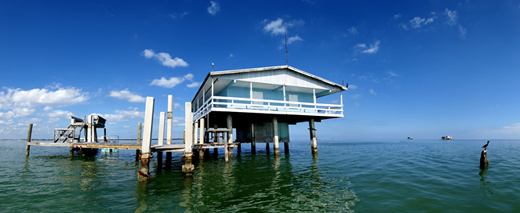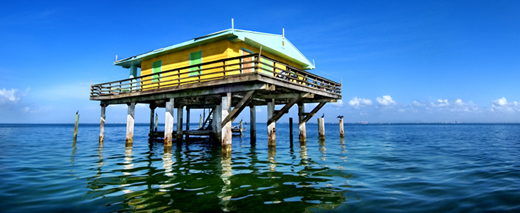
Stiltsville gives visitors unique look at bay
HOMESTEAD, Fla.— Imagine standing on the shores of Biscayne Bay just as the sun is beginning to rise. The sky is painted with shades of purples, pinks, oranges and yellows.
As the sun comes over the horizon, Easter-egg-colored houses begin to come into view out in the distance. Only these houses are not on land, they are on stilts in the middle of the water.
With a description like that, anyone, not just Floridians, would be curious to see this wonder known as Stiltsville.
 |
| Stiltsville in Biscayne Bay (Photographs courtesy of Brian Call). |
But they are accessible only by private boat.
The first dwelling to bring Stiltsville to life was built by “Crawfish Eddie Walker,” a fisherman frequently in the area, in the early 1930s. At this time, sailboats and rowboats dominated the waters. Fishermen would go out to this low-lying area of Biscayne Bay to fish for the day, go home and then return the next morning.
As a result, Crawfish Eddie got the idea to capitalize on such a popular fishing spot by setting up a bait shop to cater to the influx of fisherman. His shack was the first of many to be built on this low-lying area of Biscayne Bay known as “the flats,” a reference to its shallow one to three-foot deep waters.
 During the 1950s, the number of properties expanded to grow to 27 homes. However, when Hurricane Donna came through in 1960, 20 of these homes were damaged and only eight were repaired. In order to qualify for a repair, over 50 percent of the home needed to be damaged. The others were eventually removed.
During the 1950s, the number of properties expanded to grow to 27 homes. However, when Hurricane Donna came through in 1960, 20 of these homes were damaged and only eight were repaired. In order to qualify for a repair, over 50 percent of the home needed to be damaged. The others were eventually removed.
Over the years, hurricanes continued to torture this area. Most recently, the count of houses in Stiltsville has decreased from the original 27 to the remaining seven houses. The final blow to the pruning of Stiltsville to its current state was Hurricane Andrew in 1992.
In its heyday, Stiltsville was the place to be seen. The Bikini and Quarterdeck clubs built on a barge and piling were rumored to be home to much illegal drinking and gambling. Eventually, police got wind of these activities and closed down the clubs in a series of raids.
In 1980, the National Park Service claimed the deeds to the land and made it part of Biscayne National Park. The NPS agreed to honor the owner’s leases until they expired in 1999.
However, when that time came, Stiltsville would become full property of the state and talks of tearing down the houses were circulating.
Then, on July 22, 2003, in an effort to keep the aura of Stiltsville alive, the Stiltsville Trust Inc. was created. The trust is made up of a representative of each of the seven houses, as well as eight members at large. The members at large are representatives of conservation groups in the area and those interested in the preservation of the houses and park.
“Our main goal is to preserve the houses and provide public access,” stated Gail Baldwin, chair of the Stiltsville Trust since its inception.
Biscayne National Park came to an agreement with the members of the trust to ensure that Stiltsville was preserved to the best interest of both parties involved. The park would maintain the structures to help facilitate the trust’s use of the homes for educational endeavors and the trust would be in charge of overseeing the permitted use of the houses for events.
“We want to educate the Miami youth about the attributes of the bay and all the things that go on in the bay that probably only a few percentage know about,” Baldwin explained.
The Boy Scouts of America and Optimist Club are just two of the groups that have used the houses for their events.
While these events are common in Stiltsville, it is important to note that access is by special permission only. There are “No Trespassing” signs posted on the houses and only supervised functions approved by the Stiltsville Trust are allowed to take place.

Due to the severity of the 2005 hurricane season, many of the houses are now in need of repairs and not suitable to visitors. The torrential winds and rain ripped apart many of the areas docks and roofs. Restoration began six months ago, but is unfortunately not yet complete.
“Come summer or early spring, we hope to have at least a few of the houses open for kids groups and events,” Baldwin said.
Over the years, Stiltsville has generated its share of publicity.
Beginning with an article about the Quarterdeck Club in a 1941 issue of LIFE magazine, and more recently in 1999 featuring the houses in “Christmas Across America” on the Home and Garden Channel. It has also hosted many television commercials as well as having been the backdrop for the TV drama Miami Vice during the 1980s.
Stiltsville has brought its own unique edge to Miami and South Florida culture. Though many hurricanes and government legislation have tried to destroy this unique village, the houses of Stiltsville refuse to leave the Biscayne shores.

If You Go
Directions to Biscayne National Park (by car)
From the North: The park entrance at Convoy Point can be reached from either the Florida Turnpike or U.S. 1.
From the Florida Turnpike: Take the Florida Turnpike South, to Exit 6 (Speedway Blvd.). Turn left from the exit ramp and continue south to S.W. 328th Street (North Canal Drive). *Note* There will be a brown sign on the right-hand side of the road pointing to S.W. 328th Street. Turn left and continue until the end of the road. It is approximately nine miles and the entrance to the park is on the left.
From U.S. 1: Drive south to Homestead. Turn left on S.W. 328th (North Canal Drive), and continue until the end of the road.
 From the South:
From the South:
Traveling on U.S. 1 (Overseas Highway), drive north to Homestead. Turn right on S.W. 328th Street (North Canal Drive) and continue to the end of the road. The entrance is approximately nine miles on the left.
To learn more about Stiltsville and the Stiltsville Trust, visit http://www.stiltsville.org or contact Gail Baldwin, the Stiltsville Trust chairman, 305-443-2266.
Upon arrival at the park, park rangers at the Dante Fascell Visitor Center can direct you to Stiltsville via private boat.
To gain access to the homes of Stiltsville, please call the park superintendent, 305-230-1144, extension 3002.
Information is also available on the National Park Service’s Web site at http://www.nps.gov/bisc.
All photographs courtesy of Brian Call Photography, http://www.briancallphoto.com

Comments are Closed